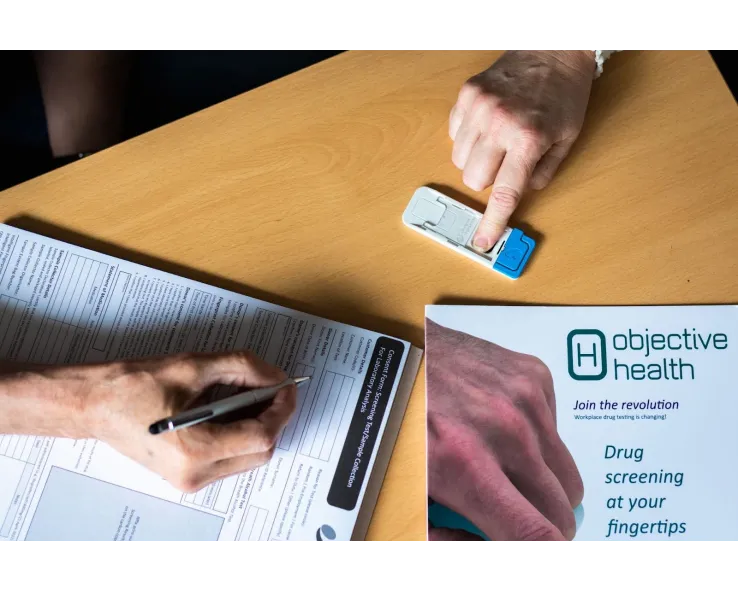If you’re an employer with responsibility for staff safety, one of the biggest challenges you face is how to run drug testing in a way that’s accurate, efficient, cost-effective, and respectful to employees.
Traditional methods like urine, blood, or saliva testing have long been the standard, but Intelligent Fingerprinting now offers an alternative that’s changing the way workplaces think about drug testing.
So what’s the difference between Intelligent Fingerprinting and traditional drug testing? And how do you decide which is right for your business?
Let’s break it down.
What Is Intelligent Fingerprinting?
Instead of collecting urine, saliva, or blood, Intelligent Fingerprinting Drug Tests uses sweat from the fingertips to test for the presence of drugs and their metabolites.
The process works like this:
Sample Collection – The employee presses all ten fingertips onto a compact drug screening cartridge. Collection takes less than a minute.
Analysis – The cartridge is inserted into the Intelligent Fingerprinting Reader, a portable device with an all-day battery and simple touchscreen.
Results – Within ten minutes, the reader provides a clear negative or “non-negative” result for each drug screened. If a non-negative result appears, a secure laboratory confirmation test can follow using liquid chromatography-mass spectrometry (LC-MS).
Because it’s quick, hygienic, and portable, this method is already used by employers across safety-critical industries for pre-employment checks, random screening, and post-incident assessments.
How Does It Compare to Traditional Drug Testing?
1. Collection Method
Traditional: Urine and saliva tests are invasive, often require dedicated facilities, and can raise privacy concerns. Blood tests require trained personnel.
Fingerprinting: Non-invasive, dignified, and hygienic. No bathrooms, medical staff, or complex logistics required.
2. Speed of Results
Traditional: Lab confirmation can take 24–72 hours. Rapid tests exist, but collection and handling still add delays.
Fingerprinting: Screening results in 10 minutes, with secure lab confirmation if needed.
3. Accuracy & Reliability
Traditional: Accurate when conducted properly, but sample tampering and adulteration are common issues with urine and saliva tests.
Fingerprinting: Samples are tamper-evident. Cartridges self-seal, and collection is supervised in seconds, reducing opportunities for substitution or contamination.
4. Operational Impact
Traditional: Testing can disrupt shifts, require external providers, or involve sending samples offsite.
Fingerprinting: Designed for on-site use. Employers can screen staff at the start of a shift, at a depot, or post-incident without leaving the workplace.
5. Employee Experience
Traditional: Many staff find urine or saliva collection uncomfortable or intrusive, which can affect morale and cooperation.
Fingerprinting: Quick, discreet, and far less intrusive, helping maintain trust and dignity in the testing process.
Why Employers Are Switching to Intelligent Fingerprinting
Businesses adopting fingerprint drug testing typically cite:
Speed – Samples collected and analysed on the spot.
Cost Control – Reduced need for third-party providers or specialist facilities.
Flexibility – Portable devices allow testing “anytime, anywhere.”
Compliance – Supports HSE, transport, and workplace safety frameworks.
Employee Wellbeing – A more respectful process that encourages cooperation.
That doesn’t mean traditional methods are obsolete. Blood tests remain the gold standard for medical and legal purposes, and urine/saliva testing is still widely used.
But for many employers, particularly those managing shift workers, logistics depots, public transport, construction, and manufacturing sites, the efficiency and practicality of Intelligent Fingerprinting make it the smarter everyday option.
Key Takeaway: Which Is Right for Your Workplace?
If your goal is fast, hygienic, and tamper-proof workplace drug screening, Intelligent Fingerprinting offers clear advantages over traditional methods.
That said, many employers use a combination of approaches, fingerprint testing for routine, in-house screening, and laboratory confirmation for non-negative results.
The real benefit is that fingerprint testing puts more control back in your hands as an employer: you can screen staff quickly, safely, and with minimal disruption, while still having the option of lab confirmation when required.
Final Word
Drug testing isn’t about catching people out, it’s about protecting your staff, your reputation, and your operations.
By understanding the differences between Intelligent Fingerprinting and traditional testing, you can choose the method (or mix of methods) that best balances speed, accuracy, dignity, and compliance in your workplace.
If you’d like to learn more about fingerprint drug testing or need help choosing the right kit, get in touch with our team today.

